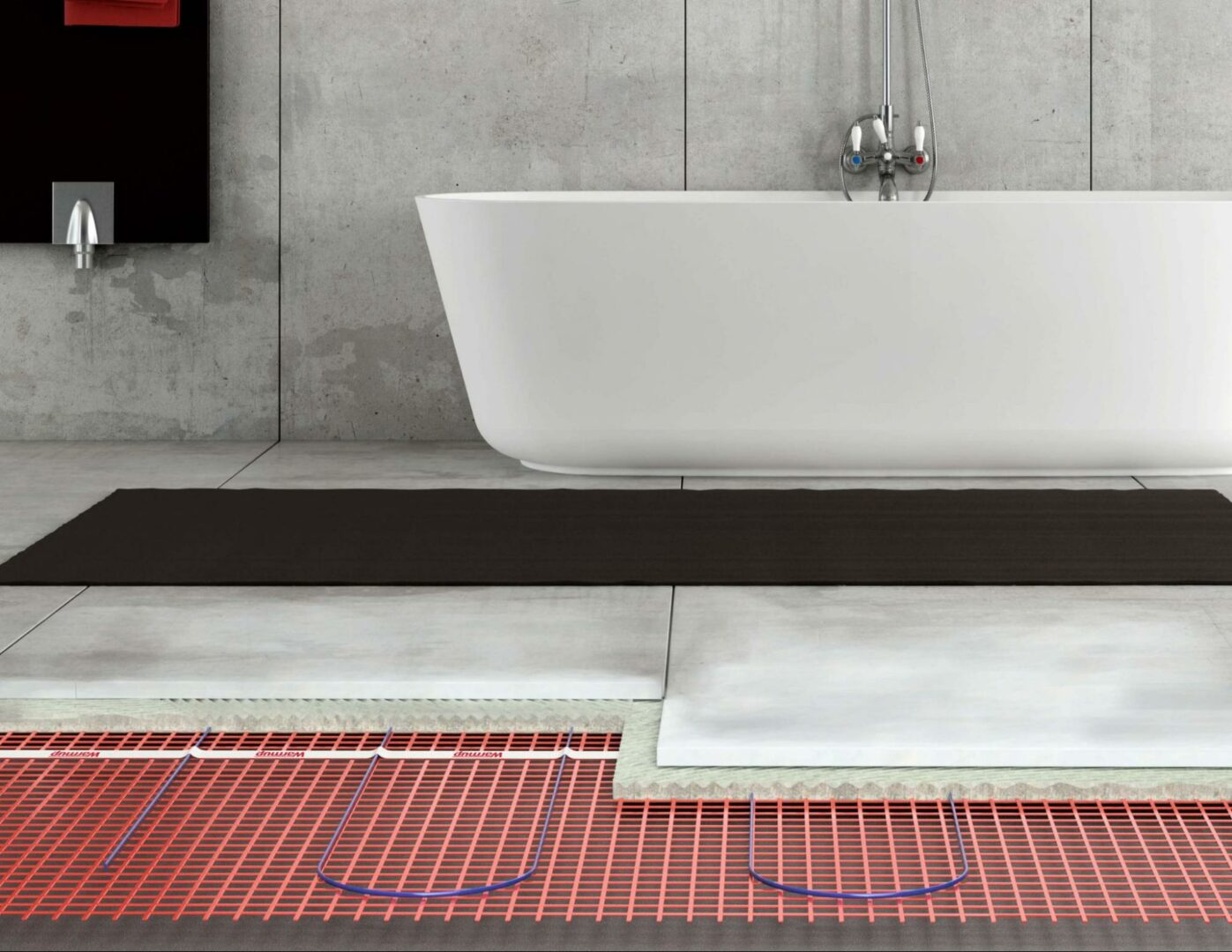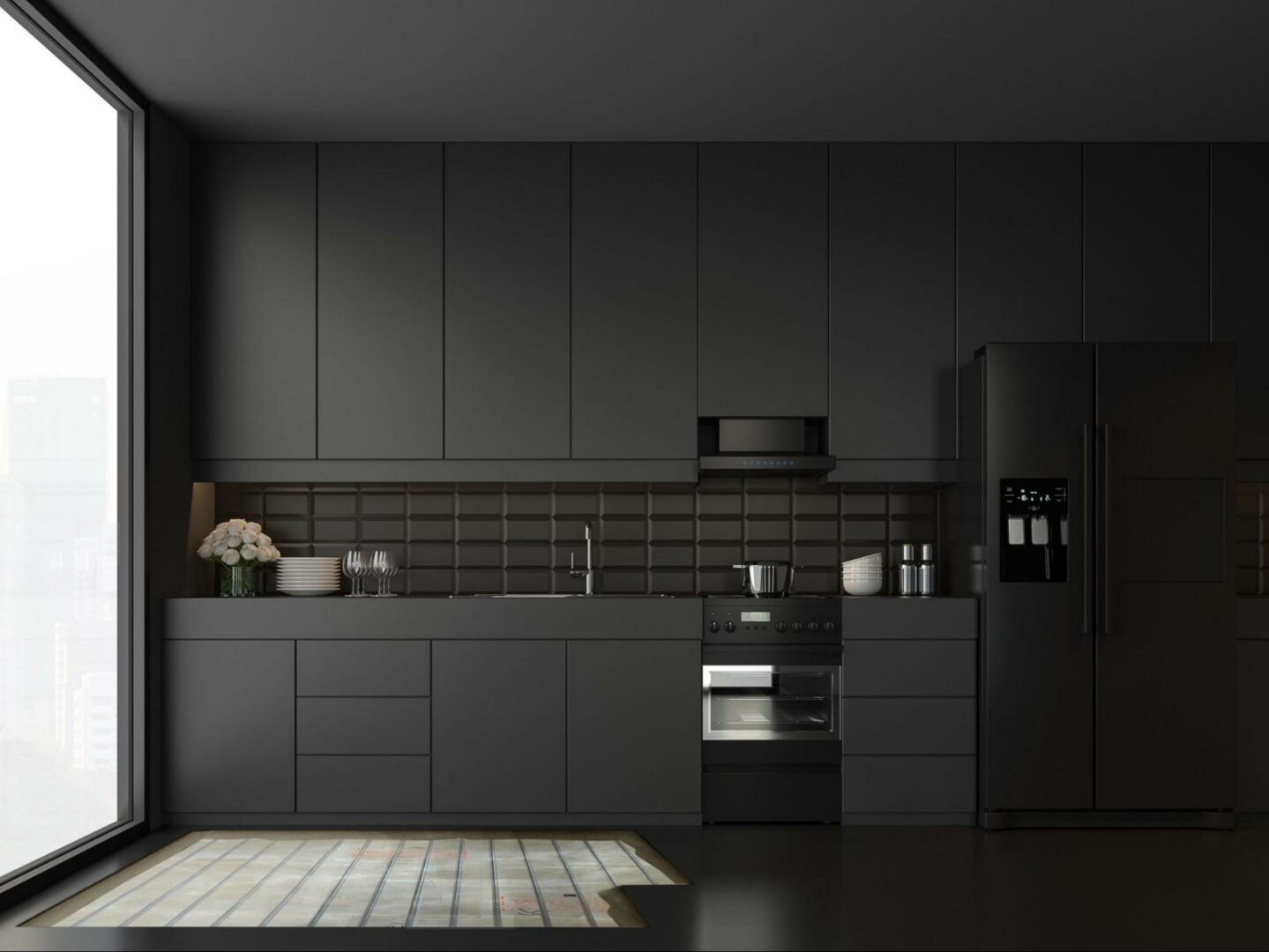Rochester, New York endures winters that carry a certain charm, but a cold and uncomfortable home doesn’t quite fit that idyllic picture. That’s where radiant floor heating comes in, by offering the promise of a warm and cozy home while also ensuring energy efficiency. This innovative heating solution not only provides unparalleled comfort, it also contributes to a more sustainable environment.

In this comprehensive guide, we will cover everything you need to know about radiant floor heating, including its environmental impact, the challenges it presents, and even how it can bring warmth to your garage or driveway.
Understanding the Climate of Rochester
Rochester, NY is known for its chilly winters, with temperatures often dropping below freezing and an average snowfall of 99 inches. Summers are relatively warm but short, so the extended cold period calls for a reliable heating solution. It provides uniform warmth from the floor upwards, which is an efficient and quiet alternative to traditional heating methods in this cold climate.
How Radiant Floor Heating Works
Radiant floor heating operates on the principle of heat transfer. In contrast to traditional heating systems that circulate warm air, radiant floor heating warms the room from the ground up – quite literally. Here’s how it works:
Heat Source: In hydronic systems, a boiler heats water, while electric systems utilize electric cables or mats. Both methods can utilize various energy sources, like electricity, gas, or solar power.
Heat Distribution: Hydronic systems circulate warm water through tubing beneath the floor, and electric systems transmit heat through electrically resistive cables or heating mats installed under the floor.
Radiant Energy: Regardless of the method, the heated floor surface radiates thermal energy upwards to directly warm objects and people in the space.
Even Temperature: Both systems deliver a uniform temperature across the room for consistent warmth from the floor upwards for comfort and efficiency.
Types of Radiant Floor Heating Systems
Hydronic (Water-Based) Systems
A hydronic system utilizes a network of polyethylene tubing (PEX) that is embedded under the floor, through which hot water is circulated in order to warm up the floor surface. A boiler heats the water, and a pump circulates it through the tubing. The heat is then radiated from the floor and distributed uniformly throughout the room. This system can be used under a variety of floor surfaces such as tile, wood, and even carpet.
Electric Systems
An electric system is made up of electric cables or mats of electrically conductive plastic built into the floor that work by running an electric current through the elements to generate heat. They are often quicker and easier to install than their hydronic counterparts and don’t require a boiler or pump.
Comparison of Hydronic and Electric Systems
When deciding between hydronic and electric radiant floor heating systems, there are several key factors to consider:
Efficiency and Cost-Effectiveness
Hydronic systems tend to be more energy-efficient and cost-effective for whole-house heating, especially given the relatively high cost of electricity in Rochester, NY. Once installed, they can provide a significant reduction in heating bills over the long-term.
In contrast, while electric systems are often less expensive to install, they can be costlier to operate in the long run, especially for larger spaces.
Installation Complexity
Electric systems typically offer a simpler installation process, which makes them a popular choice for homeowners undertaking DIY projects or smaller renovations.
Hydronic systems deliver excellent efficiency, but require professional installation due to the complexity of installing a network of pipes, a boiler, and a pump.
Flexibility and Control
Electric systems can be easily controlled via your home’s electrical system for quicker heat adjustment according to your comfort.
Hydronic systems provide consistent, comfortable warmth, but may take longer to adjust due to the time it takes for the water to heat up and circulate through the pipes.
Health Benefits
Both systems offer the advantage of reducing drafts and the circulation of dust and allergens, for a healthier living environment.
It’s highly recommended to consult with a local radiant floor heating expert to determine the best solution for your individual circumstances.
Advantages of Radiant Floor Heating
Energy Efficiency and Cost Savings
Radiant floor heating can be more energy-efficient than traditional heating methods because it heats objects and people directly, which reduces the amount of heat needed to achieve comfort. Efficient operation and zoned heating usage can also contribute to long-term cost savings on energy bills.
Even and Consistent Heating
Radiant floor heating delivers uniform heat across the entire floor surface, and eliminates the hot and cold spots that can occur with other heating methods. Consequently, everyone can experience consistent warmth throughout the room.
Improved Indoor Air Quality
Unlike forced-air systems, radiant floor heating doesn’t distribute dust, allergens, or other airborne particles throughout the space, which potentially improves indoor air quality. It operates silently and without needing to blow air around, to help contribute to a cleaner indoor environment.
Design Flexibility and Space Saving
Radiant floor heating systems are hidden beneath the floor to save space and offer design flexibility, as there’s no need to accommodate radiators or vents. This allows more freedom in planning interior layouts and placing furniture.
Reduced Noise Compared to Forced-air Systems
Since radiant floor heating doesn’t rely on blowers or fans, it operates more quietly compared to forced-air systems. It helps to create a quieter indoor environment, which can enhance comfort and tranquility within the living space.
Radiant Floor Heating Installation Process

Pre-installation Considerations
A deeper dive into the pre-installation phase reveals several crucial aspects:
Assessing the Heat Load: Determine the heat load of the space by calculating the BTUs (British Thermal Units) needed to adequately warm the area, considering factors like outdoor temperatures, insulation levels, and window sizes.
Selecting a System: Decide between a hydronic or electric radiant heating system based on factors like installation cost, running cost, and the intended use of the space.
Compatibility with Existing HVAC: Evaluate how the radiant floor heating will integrate with existing heating, ventilation, and air conditioning (HVAC) systems, and whether it will serve as the primary or supplementary heating source.
Control and Zoning: Plan for the control system, and consider whether the radiant floor heating will be zoned to allow for different temperature settings in various areas of the space in order to enhance energy efficiency and user comfort.
Safety and Compliance: Ensure that the installation complies with local building codes and regulations. All safety measures, such as using a licensed electrician for any electrical work related to the installation, should be adhered to.
Timeline and Disruption: Understand and plan for the duration of the installation process, and consider potential disruptions, especially in retrofit scenarios, to minimize inconvenience.
By considering these factors, you can help to ensure a successful and efficient radiant floor heating system.
Flooring Types Suitable for Radiant Heat
Various flooring types can be utilized with radiant floor heating, including tile, stone, laminate, and some types of engineered wood. The chosen material should ideally have good conductive properties to effectively transfer heat. Some materials, like thick carpet, may impede heat transfer and are generally not recommended.
Insulation and Subfloor Requirements
Proper insulation is vital to prevent heat loss and ensure that the system works efficiently. Insulation is typically installed beneath the heating system to direct the heat upwards into the room. The subfloor should be stable, clean, and level in order to support the heating elements, whether they are hydronic tubes or electric mats, and to help ensure even heat distribution across the floor.
These guidelines can help to ensure an informative, and practical approach to installing radiant floor heating systems.
Radiant Floor Heating Cost Considerations
Initial Installation Costs
Understanding the initial installation costs of radiant floor heating systems is key to effectively planning your budget, including considerations such as the type of system selected and the size of the area to be heated:
System Type: Electric systems typically have lower installation costs compared to hydronic systems.
Floor Preparation: Additional preparation like leveling or reinforcing may be required.
Material Costs: Materials costs include the heating cables or tubes, manifolds, and controllers.
Labor Costs: Professional installation can vary based on complexity and location.
Additional Equipment: For hydronic systems, boilers or heaters may be needed, which can affect the initial costs.
Operating Costs and Energy Savings
Operating costs and potential energy savings play a key role in the overall cost-effectiveness of a radiant floor heating system, which makes them critical considerations when assessing the long-term value:
Energy Source: The cost of electricity, gas, or other fuel sources will impact operating costs.
System Efficiency: Modern systems with Smart controls can optimize energy use to potentially reduce operating costs.
Maintenance: Electric systems generally require less maintenance than hydronic systems, which can help to reduce long-term operational costs.
Zoning: Using zoned systems allows for heating only the occupied areas for potential energy savings.
Return on Investment (ROI)
Investing in a radiant floor heating system goes beyond the immediate warmth and comfort it provides; it also has long-term financial advantages:
Increased Efficiency: Efficient radiant heating may reduce overall energy bills for an improved ROI.
Home Value: The installation of radiant floor heating can potentially increase property value.
Longevity: With proper installation and maintenance, radiant heating systems can have a long lifespan that can extend the period over which the ROI is realized.
Comparative Savings: Weighing the investment against potential energy savings over time will provide a clearer picture of ROI.
Comfort Value: While not easily quantified, the increased comfort provided by radiant heating can be viewed as a positive return on investment.
While the upfront cost may be higher than traditional heating methods, considering the long-term benefits and the ROI, radiant floor heating is an exceptionally worthwhile investment for your home.
Environmental Benefits of Radiant Floor Heating

Energy Efficiency and Reduced Carbon Footprint
Radiant floor heating is a highly efficient way to keep your space warm. It distributes heat evenly and uses less energy than traditional heating methods while still maintaining comfort. With reduced heat loss and lower operating temperatures, this system helps minimize energy consumption.
By effectively using less energy, you can not only save on your energy bills, but also contribute to lowering carbon emissions. Consider pairing it with low-carbon or carbon-neutral energy sources for an even smaller carbon footprint.
Compatibility with Renewable Energy Sources
Radiant floor heating systems can be paired with renewable energy sources, such as solar or geothermal energy to reduce reliance on fossil fuels, and help to decrease the overall carbon footprint of the heating system.
Integrating Smart controls and thermostats with the system allows for the optimized use of renewable energy, and improves system efficiency and sustainability.
Challenges and Considerations When Considering Radiant Floor Heating
Retrofitting Existing Homes with Radiant Floor Heating
Installing radiant floor heating in existing homes, or retrofitting, can present several challenges:
- The existing floors will likely need to be removed and replaced, which can be invasive and time-consuming.
- Accessibility of the spaces underneath the floor might also pose a challenge, especially in older homes with structural limitations.
- The current heating system and how the new radiant heating will integrate, or replace it, is critical.
- Financially, retrofitting can be quite costly due to the potential need for new flooring, labor, and heating materials.
Regulatory and Code Compliance
Ensuring that a radiant floor heating system complies with local building codes and regulations is crucial. The installation will need to meet specific safety and quality standards, which might involve securing permits or arranging for inspections.
Depending on the jurisdiction, there can be varying regulations concerning energy use, electrical work, and building practices that must be adhered to during installation. For residential areas, homeowner association (HOA) rules might also impact the installation process, and may require additional approvals or documentation.
Radiant Floor Heating for Garages, Driveways, and Walkways

Radiant floor heating isn’t just for the interior of your home. It can also be used for your garage, driveway, and walkways, particularly during extreme winter weather conditions.
Garage Comfort
Radiant floor heating in a garage provides a consistent warmth across the floor, to enhance the usability and comfort of the space during colder months.
Whether the garage is used for vehicle storage, a workshop, or a recreational area, a heated floor improves the environment by maintaining a stable, warm temperature that makes it practical and comfortable even in winter.
Snow-Free Driveways
Installing radiant floor heating under a driveway helps to melt snow and ice during the winter season, and to reduce the need for physical shoveling or the use of de-icing chemicals. This not only minimizes the labor and time spent on snow removal, but also enhances safety by reducing the risk of slips and falls. It also prevents potential damage or wear to the driveway surface from repetitive freeze-thaw cycles.
Warm Walkways
Radiant heating systems beneath a walkway can serve a dual purpose: To provide a safe, ice-free path and enhance comfort for those walking barefoot or with minimal footwear during cooler weather. By maintaining a steady warmth, it prevents the accumulation of ice and snow, to help ensure a clear, safe path around a property while also providing a pleasantly warm surface underfoot.
Whether you’re looking at enhancing comfort in your home, reducing your carbon footprint, or making outdoor spaces more usable year-round, radiant floor heating is a viable, energy-efficient solution.
Work with Warmup for the Best in Radiant Floor Heating for Rochester, New York
When it comes to radiant floor heating, Warmup stands as the leader in quality, innovation, and customer service. We have decades of experience in the industry, and we have a broad range of heating solutions tailored to meet the needs of your home or business. Our team of experts will guide you through the entire process, from understanding your heating needs to selecting the most suitable system for a seamless installation.
Contact us today for more information and a free quote!


